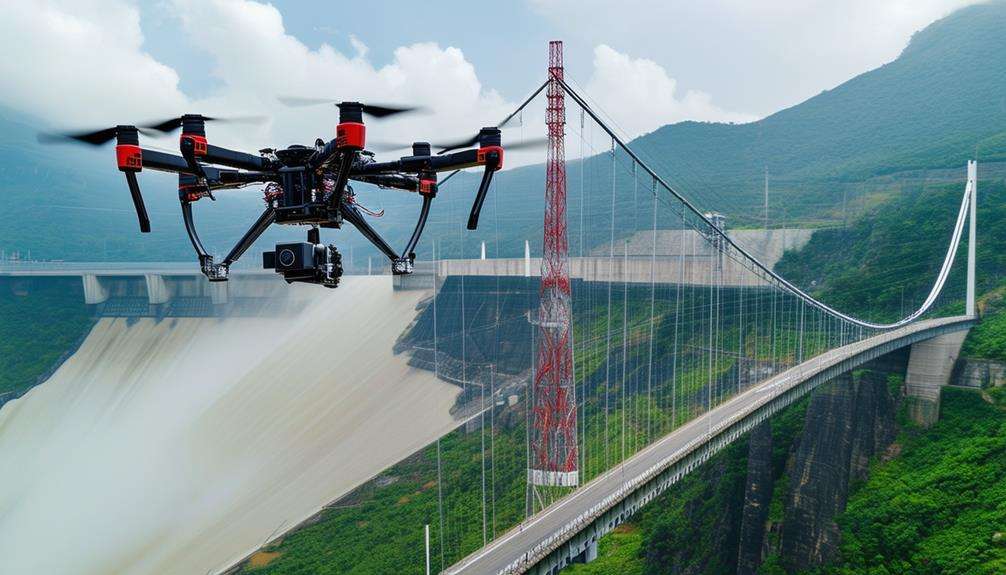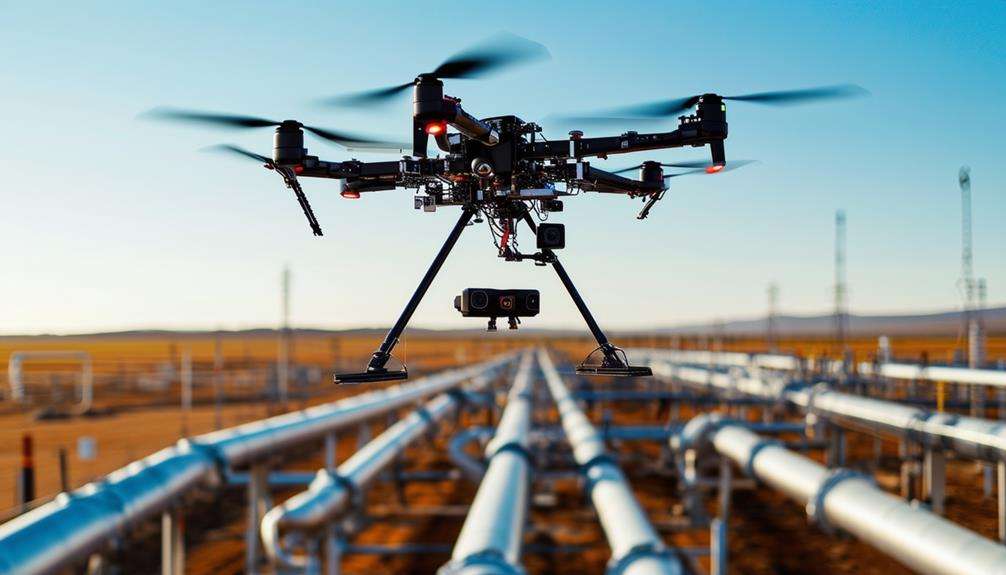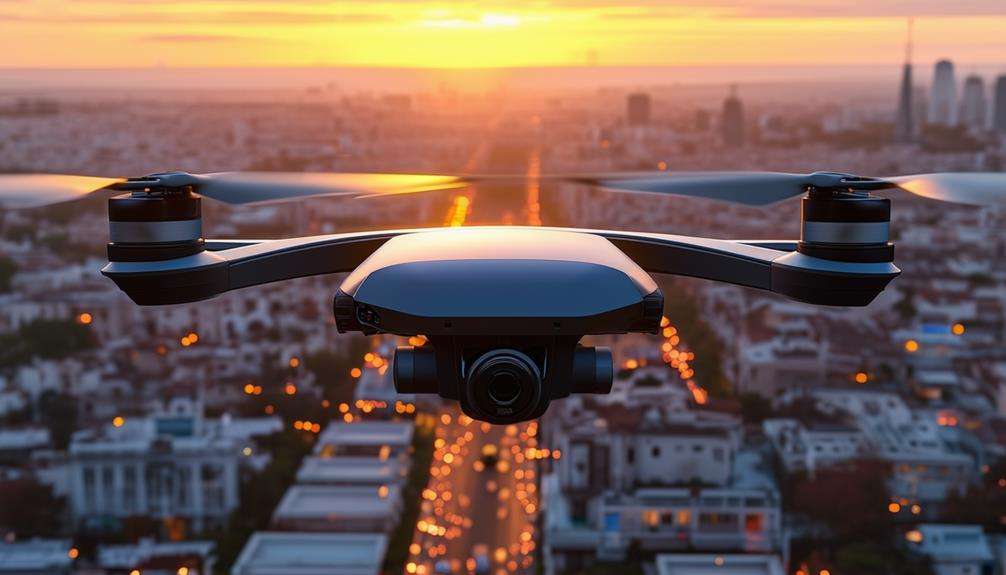The Future of Drone Swarms in Commercial Applications
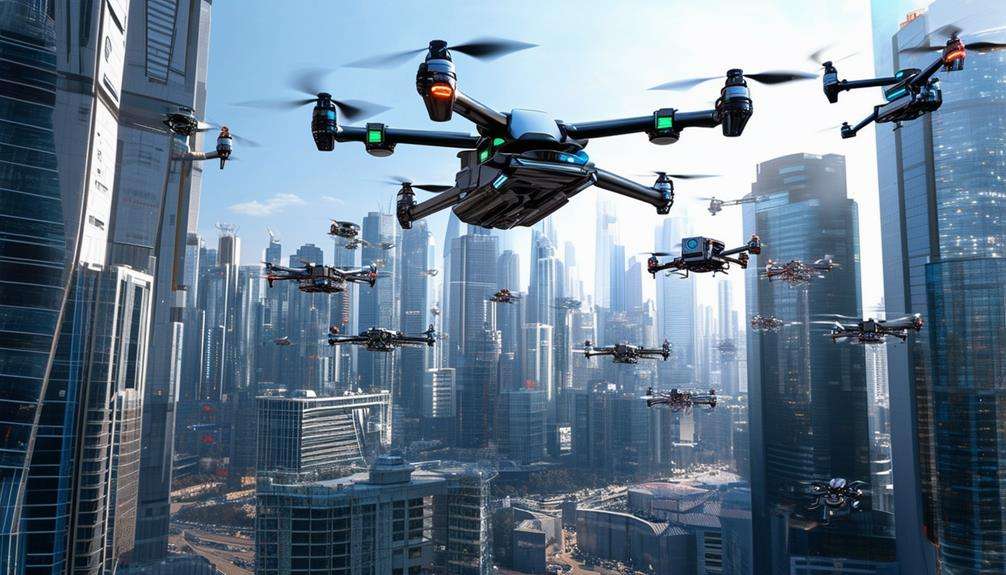
Imagine a world where drone swarms revolutionize industries such as agriculture, construction, and logistics. Farms could become optimized for precision agriculture, construction sites could be surveyed with unparalleled accuracy, and supply chains could be streamlined more efficiently than ever before.
Advances in connectivity and autonomous decision-making are poised to redefine operational effectiveness, offering not just speed but also cost-effectiveness and resource optimization. Curious about the potential impact on business operations and resource management? These possibilities are closer than ever and are continually evolving.
Agricultural Efficiency
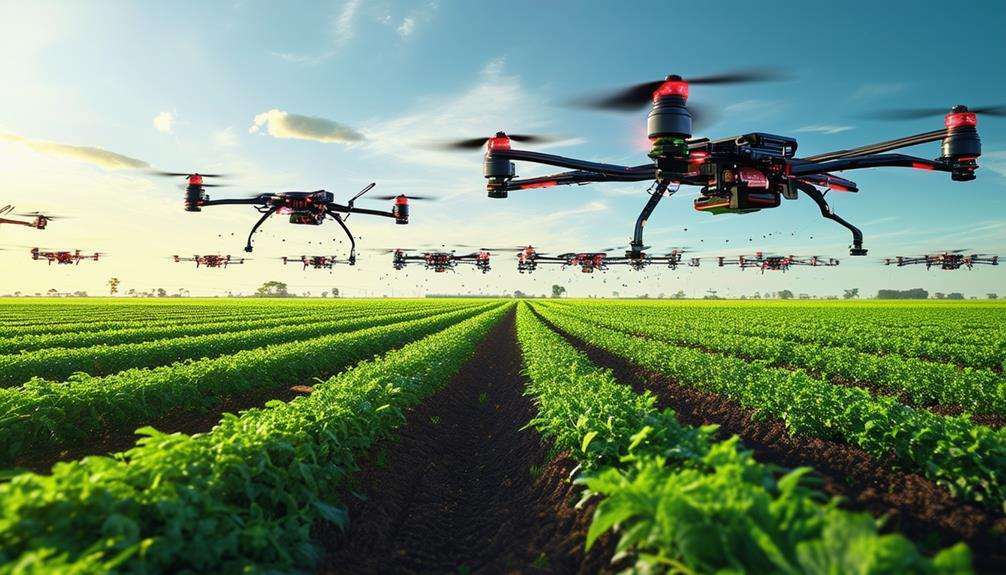
Drone swarms are transforming agricultural efficiency by enabling precise and simultaneous tasks such as planting seeds and applying crop treatments. These drones collaborate to cover large areas rapidly, ensuring every seed is planted with exact precision, significantly reducing planting time and optimizing resource use.
In precision agriculture, real-time monitoring of crop health, irrigation needs, and soil conditions is crucial. Autonomous drone swarms excel in this area by employing advanced sensors to gather data on plant health, growth patterns, and environmental factors. This data empowers farmers to make informed decisions, improving yield predictions and minimizing resource waste. No longer is there a need to guess where to water or when to apply fertilizers; drone swarms provide accurate insights.
Additionally, drone swarms offer rapid, cost-effective aerial surveys of extensive agricultural areas, facilitating timely decision-making and enhancing farm productivity. By adopting drone swarms, farmers not only stay current with technological advancements but also lead in agricultural efficiency.
Construction Innovation
Imagine transforming your construction site with the power of drone swarms. Efficient site surveys and autonomous material delivery become the new standard, enabling faster, more accurate data collection and streamlined logistics.
This technology enhances project timelines and productivity, setting a new benchmark in construction efficiency. By embracing drone swarms, you're not just innovating; you're leading the future of construction.
Efficient Site Surveys
Leveraging drone swarms for construction site surveys enables rapid and highly accurate data collection. These coordinated drones capture detailed aerial imagery essential for precise topographic mapping. Utilizing drone swarms accelerates the survey process and provides real-time high-resolution imagery, optimizing construction planning and project management.
Advanced AI algorithms process the data from these drones, ensuring the information is both accurate and actionable. This detailed data aids in monitoring progress and identifying potential issues before they escalate into costly problems. The efficiency of drone swarms allows for pinpointing areas of concern without the need for physical site visits.
In addition to enhancing accuracy, drone swarms significantly reduce survey time and costs. Traditional methods are often labor-intensive and slow, whereas drone swarms can cover extensive areas quickly. This approach not only saves time but also improves data quality, making construction projects more efficient and less error-prone.
Autonomous Material Delivery
Autonomous drone swarms are revolutionizing construction logistics by delivering materials swiftly and securely to even the most challenging sites. By harnessing the capabilities of commercial drones, construction firms can optimize logistics and significantly shorten project timelines. Drone swarming facilitates the efficient transportation of construction materials to remote or hazardous locations with minimal human intervention.
Real-time data processing and advanced AI algorithms are crucial in enhancing the accuracy and safety of these material delivery operations. These technologies ensure that each drone in the swarm can navigate complex environments and deliver materials precisely where needed. This combination of precision and efficiency isn't just an innovation; it's a practical solution that construction companies are increasingly adopting to streamline their supply chain management.
Commercial drone swarms provide a cost-effective solution that enhances efficiency and promotes construction site safety. By reducing the need for human workers to transport materials to difficult-to-reach areas, companies can cut costs and minimize the risk of accidents. In an industry where time and safety are critical, drone swarming is proving to be transformative.
Logistics Optimization
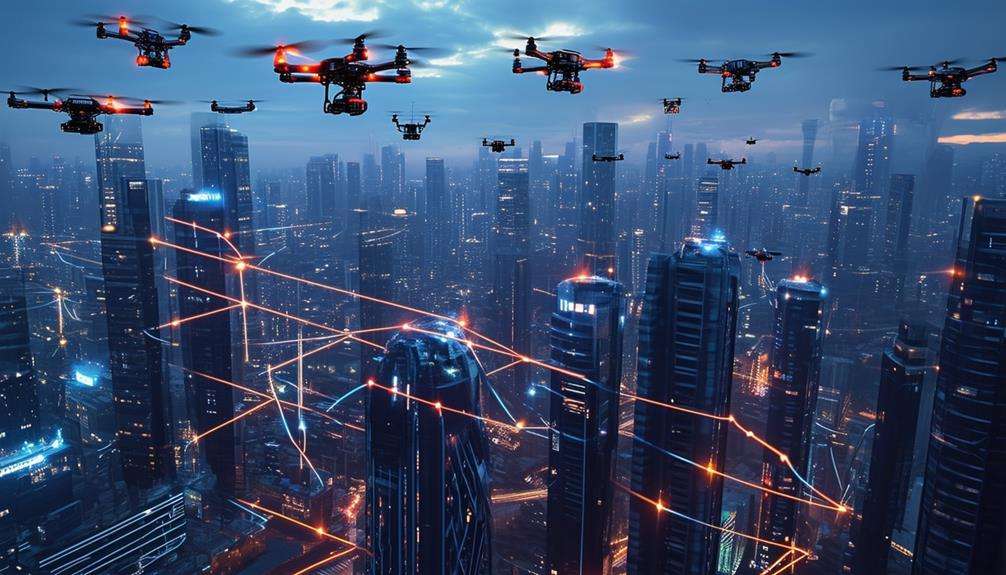
Drone swarms are transforming logistics by coordinating multiple drones to transport goods more efficiently. They streamline package delivery routes, making the entire process faster and more cost-effective. A swarm of drones working in unison can handle various parts of the delivery chain, reducing delivery times and optimizing resource use, especially in congested urban areas.
Incorporating drone swarms into logistics operations enhances last-mile delivery capabilities. These drones navigate through traffic and deliver packages directly to customers' doorsteps, bypassing common urban obstacles, resulting in quicker deliveries and increased customer satisfaction.
Moreover, drone swarms improve inventory management and supply chain efficiency. Coordinated drone operations provide real-time updates on stock levels, reducing the risk of overstocking or understocking. This precision leads to a smoother and more reliable supply chain.
The future of commercial logistics likely includes widespread adoption of drone swarm technology. Embracing this innovative approach sets the stage for a logistics system that's faster, more reliable, and cost-effective.
Environmental Monitoring
As logistics optimization continues to advance with drone swarms, these versatile devices are also revolutionizing environmental monitoring by providing real-time data crucial for tracking wildlife and evaluating climate change impacts. Drone swarms equipped with advanced sensors can monitor ecosystems, yielding critical environmental data that is invaluable for research and conservation efforts.
Drone swarms offer a cost-effective and efficient solution for monitoring air quality, water resources, and biodiversity. Their ability to cover large areas rapidly results in detailed and accurate data essential for environmental evaluations. Furthermore, drone swarms aid in the early detection of natural disasters such as wildfires, floods, and landslides, enabling quicker response times and potentially saving lives and property.
Here's a visual representation of the key benefits and applications:
| Benefits | Applications |
|---|---|
| Real-time data | Tracking wildlife |
| Cost-effective | Monitoring air quality |
| Efficient coverage | Evaluating water resources |
| Early disaster detection | Examining climate change impacts |
The future of drone swarms in environmental monitoring is promising. By integrating these technologies, we can enhance our efforts to protect and better understand our planet.
Enhanced Connectivity
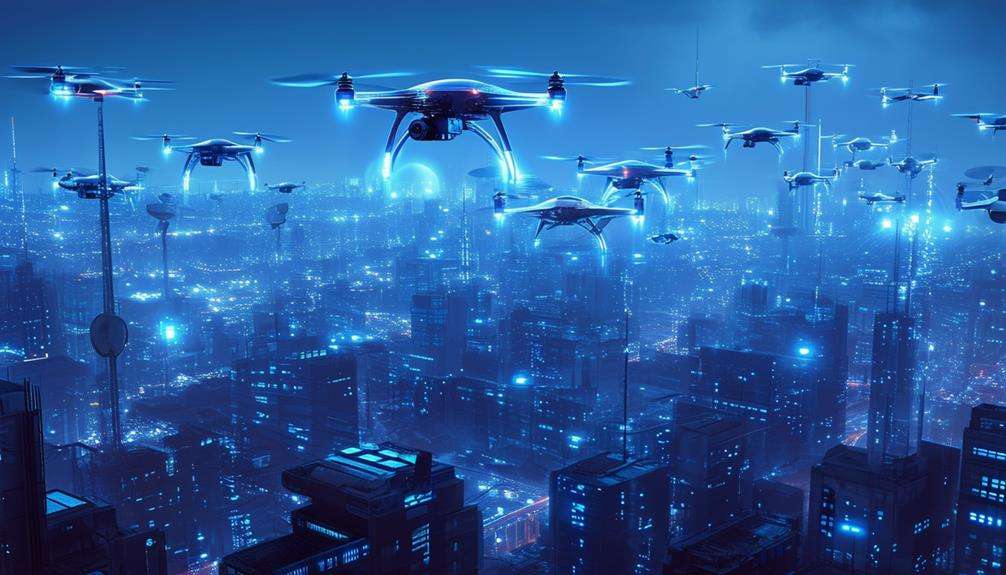
High-speed networks like 5G are revolutionizing drone swarms by enabling real-time data transmission and enhancing operational efficiency. With 5G, drone swarms benefit from unprecedented connectivity, extending their operational range and coverage. This improved communication with control centers ensures reliable and seamless operations.
Future advancements in connectivity will enable more sophisticated applications of drone swarm technology. Edge video intelligence solutions can process data closer to where it's generated, making drone operations more scalable and efficient. This real-time video processing capability is crucial for instant decision-making in complex tasks.
Drone swarm technology also benefits from seamless integration with existing cellular infrastructure, supporting real-time telemetry and control, and making operations smoother and more reliable. Drones can fly over vast areas, collect data, and relay it back instantly, all while maintaining constant communication with each other and human operators.
Improved connectivity isn't just about stronger signals; it's about creating a robust network that supports the sophisticated needs of modern drone applications. Looking to the future, the potential for innovation in drone swarm technology is immense, driven by these advancements in connectivity.
Task-Based Autonomy
When considering task-based autonomy in drone swarms, real-time decision-making is crucial. Autonomous task allocation ensures that each drone collaborates effectively to complete complex missions. This coordinated approach enables drone swarms to adapt dynamically to changing conditions, enhancing their efficiency across various commercial applications.
Real-Time Decision Making
Real-time decision-making in drone swarms allows them to adapt swiftly and efficiently to dynamic commercial environments. By leveraging AI algorithms, drones can process real-time data, make quick decisions, and optimize their performance for various tasks. This autonomy ensures that drones can navigate changing conditions, avoid obstacles, and complete missions with high efficiency.
Consider a scenario where a fleet of drones is tasked with inspecting a large solar farm. With real-time decision-making, these drones can autonomously adjust their flight paths when encountering unexpected obstacles like birds or other drones. AI algorithms enable them to assess situations instantaneously and make optimal choices, ensuring the task is completed safely and efficiently.
Emotional Impacts of Real-Time Decision-Making
| Benefit | Impact | Emotion Evoked |
|---|---|---|
| Increased Efficiency | Faster task completion | Satisfaction |
| Enhanced Safety | Fewer accidents and mishaps | Relief |
| Cost-Effectiveness | Reduced operational costs | Optimism |
| Reliability | Consistent performance | Trust |
| Innovation | Advanced capabilities | Excitement |
Real-time decision-making capabilities in drone swarms not only improve operational efficiency but also ensure safety and reliability, making them indispensable in modern commercial applications.
Autonomous Task Allocation
Autonomous task allocation leverages real-time decision-making to enable drone swarms to distribute specific tasks efficiently among individual drones based on current data and mission objectives. By using AI, these drone swarms can autonomously decide on roles such as reconnaissance, surveillance, or payload delivery, ensuring each drone undertakes the most suitable function.
This task-based autonomy optimizes efficiency in commercial drone operations. Drones dynamically communicate and collaborate to allocate tasks, adapting to changing conditions and priorities in real time. This capability allows for a more coordinated and effective performance, making operations smoother and more reliable.
Beyond efficiency, autonomous task allocation enhances scalability and adaptability. As commercial needs evolve, drone swarms can be scaled up or down, performing complex missions with ease. This flexibility ensures that, regardless of the size or scope of the task, your drone swarm can handle it proficiently.
Coordinated Multi-Drone Operations
How do coordinated multi-drone operations revolutionize commercial applications with task-based autonomy? By allowing drones to work autonomously in tandem, remarkable efficiency and effectiveness can be achieved across various industries. Task-based autonomy facilitates seamless collaboration among drones, making them ideal for complex tasks such as search and rescue missions or large-scale inspections.
Consider a scenario where a swarm of drones conducts an extensive inspection of a construction site. Coordinated operations ensure each drone understands its specific role and area to cover, optimizing the entire process. This not only accelerates the task but also guarantees thorough coverage, minimizing human error.
In search and rescue missions, drone swarms can rapidly scan vast areas, identify survivors, and relay critical information to rescue teams. Task-based autonomy allows for dynamic reallocation of tasks among the drones, ensuring efficient use of resources and minimizing wasted time.
Utilizing coordinated operations in commercial applications significantly boosts productivity and resource management. Drone swarms with task-based autonomy can adapt to changing conditions, making them invaluable in sectors like agriculture, logistics, and infrastructure maintenance. By embracing this technology, complex tasks can be handled more swiftly and accurately than ever before, setting the stage for a more efficient future.
Edge Video Intelligence
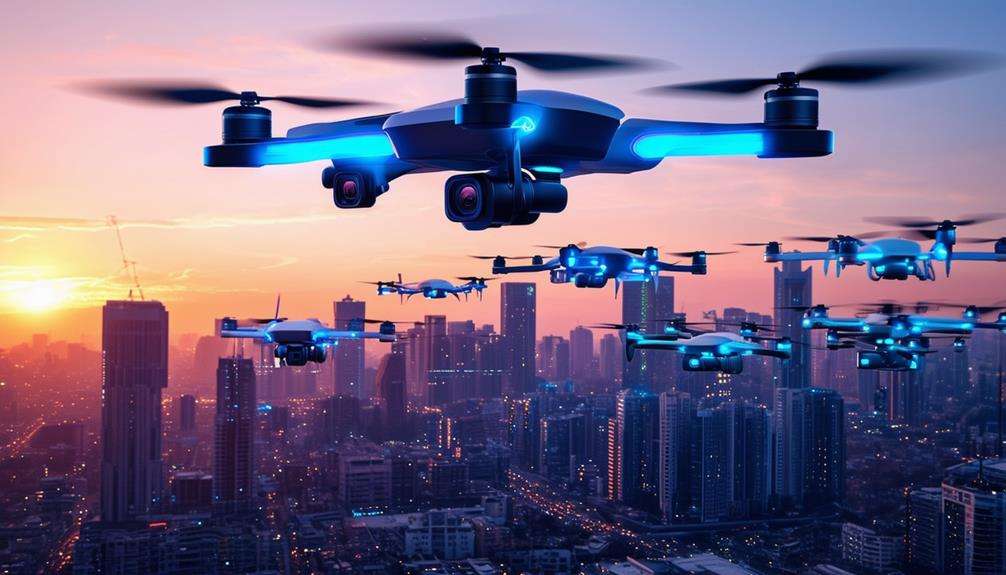
Edge video intelligence introduces unprecedented real-time processing capabilities to drone swarms, enabling them to make swift and informed decisions directly at the source. By processing data closer to where it's collected, drones can significantly reduce latency and enhance their overall efficiency. This is crucial for commercial applications where timely decision-making is essential.
Here are three key benefits of edge video intelligence in drone swarms:
- Enhanced Scalability and Efficiency: Edge video intelligence minimizes the need for continuous data transmission to centralized servers. This not only reduces latency but also enhances the scalability of drone operations, allowing for larger swarms without straining network resources.
- Improved Connectivity and Collaboration: With edge video intelligence, drones can communicate more effectively, sharing data and insights in real-time. This heightened connectivity facilitates better coordination and collaboration, which is vital for complex commercial tasks such as surveillance, agriculture, and logistics.
- Seamless Integration with Existing Infrastructure: Edge video intelligence solutions can effortlessly integrate with current cellular networks, optimizing data processing and analysis. This ensures that drones can function efficiently even in remote or challenging environments.
Green Technology
As the drone industry evolves, green technology is becoming essential for reducing environmental impact and enhancing sustainability. By leveraging renewable energy sources like solar panels and hydrogen fuel cells, green drones significantly decrease their carbon footprint. This shift aligns with global environmental sustainability goals and enhances drone operational efficiency. Energy-efficient designs enable these drones to achieve extended flight times, reducing the need for frequent recharges.
Eco-friendly drone solutions are particularly beneficial for applications such as wildlife monitoring and conservation efforts. These green drones utilize clean energy sources, minimizing emissions and advancing conservation objectives. The development of green drone technology underscores the industry's commitment to environmental sustainability.
Switching to green drones means adopting innovative technology while contributing to a more sustainable future. In commercial applications, this can result in long-term savings and a reduced ecological footprint. By integrating renewable energy sources into drone technology, you contribute to a cleaner, more sustainable world and enhance the operational capabilities of your drone fleets.
Conclusion
You're on the cusp of a commercial revolution with the advent of drone swarms. These technological marvels will enhance agricultural efficiency, bring innovation to construction, streamline logistics, and advance environmental monitoring.
Leveraging advanced connectivity and autonomous task management, your operations will become faster and more precise. Integration of edge video intelligence and green technology will make your practices smarter and more eco-friendly. Embrace this future to achieve significant gains in productivity, cost-effectiveness, and overall efficiency across your industry. The sky's the limit!

